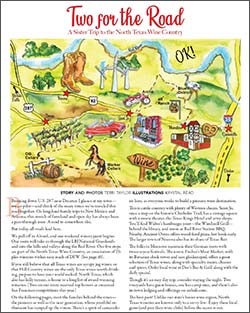Photography Daniel Gerona and Texas Fungus
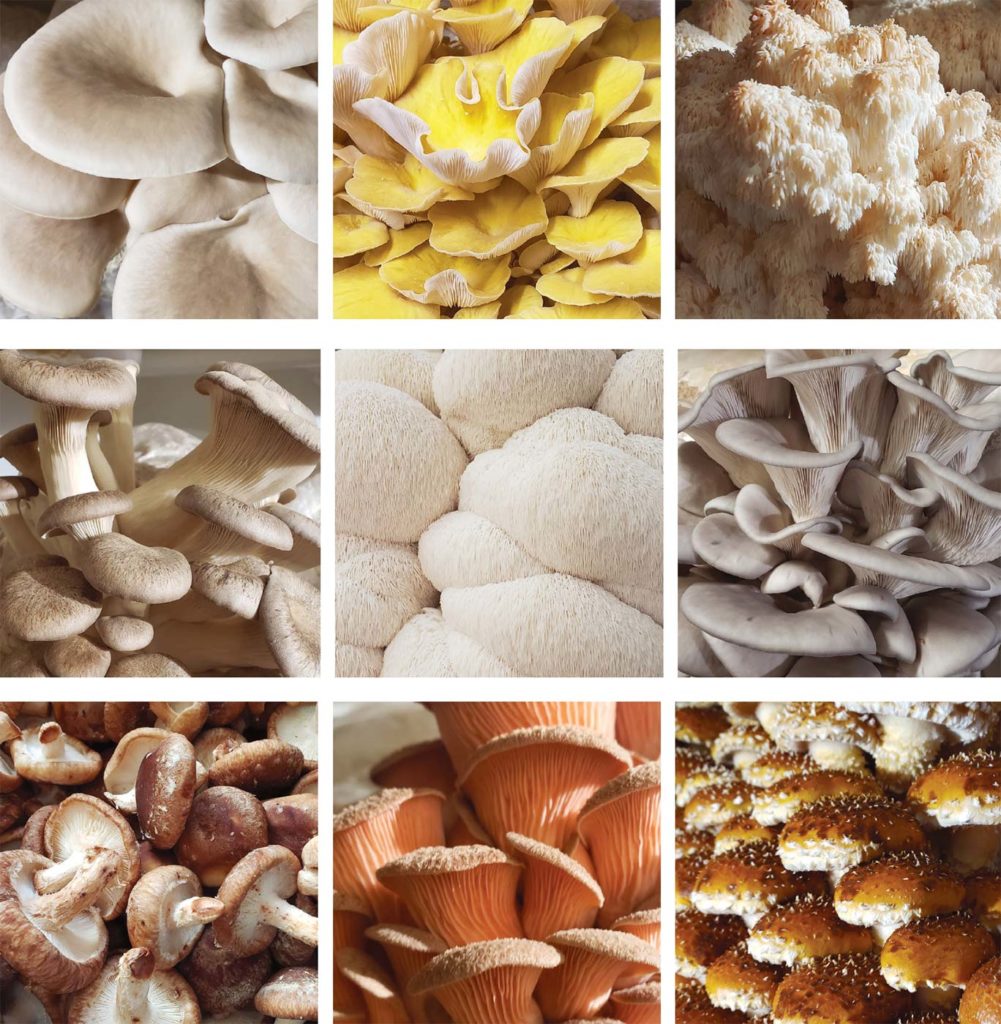
Two years after a chance online introduction, partners Adam Cohen and Jordan Jent began working together to build Texas Fungus, a fully integrated indoor “farm” in Arlington that grows culinary mushrooms from (agar) plate to (dinner) plate. You might have seen one of their fungi-filled booths at a local farmers market or stocking the H-E-B Central Market on Lovers Lane in Dallas, each full to their gills with a variety of mushroom species, plump, savory and ready to be prepared by home chefs across North Texas. But that retail model, selling to the public, was not initially the focus of their original business plan.
When Texas Fungus was cultivated in 2019, restaurant-seasoned Jent was looking to get out of a short stint in corporate America. And after 20 years of teaching, Cohen was trying to branch out from his part-time aquaponic farm. Their initial business model was focused on supplying mushrooms to the most prestigious high-end restaurants and farm-to-table focused eateries across the metroplex. The small number of mushrooms they had leftover was then sold at two local Farmers Markets.
That model was doing well based on both their accounts, with business growing significantly until the end of January 2020.
“Thirty days later, we watched as all restaurants were forced to shut down in what was, until then, an absolutely inconceivable situation. That forced us to massively rethink our entire business model and distribution plans,” says Cohen.
Going out on a limb, Cohen and Jent began to transform their operation by necessity. They built resiliency by developing growat- home mushroom kits, mushroom extracts, mushroom seasoning salts, and eventually expanded selling their products at eight farmers markets, in a bid to transition to a retail focus. They hoped to make up the gap in lost restaurant sales to keep their budding business afloat.
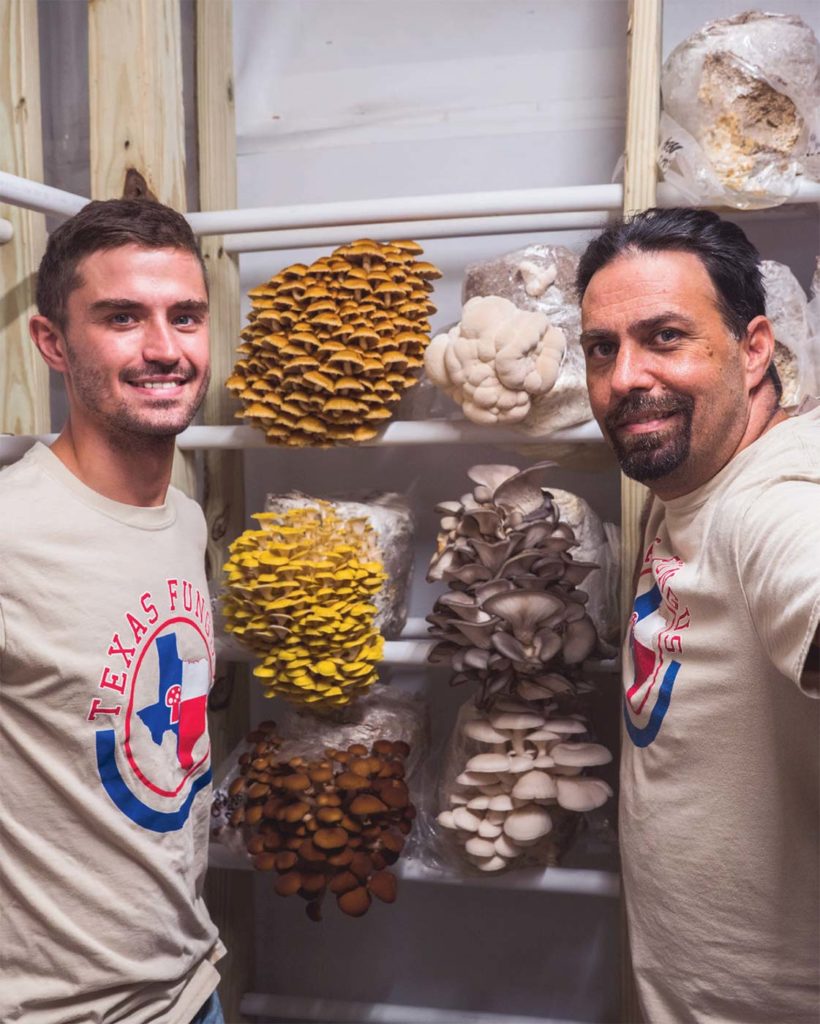
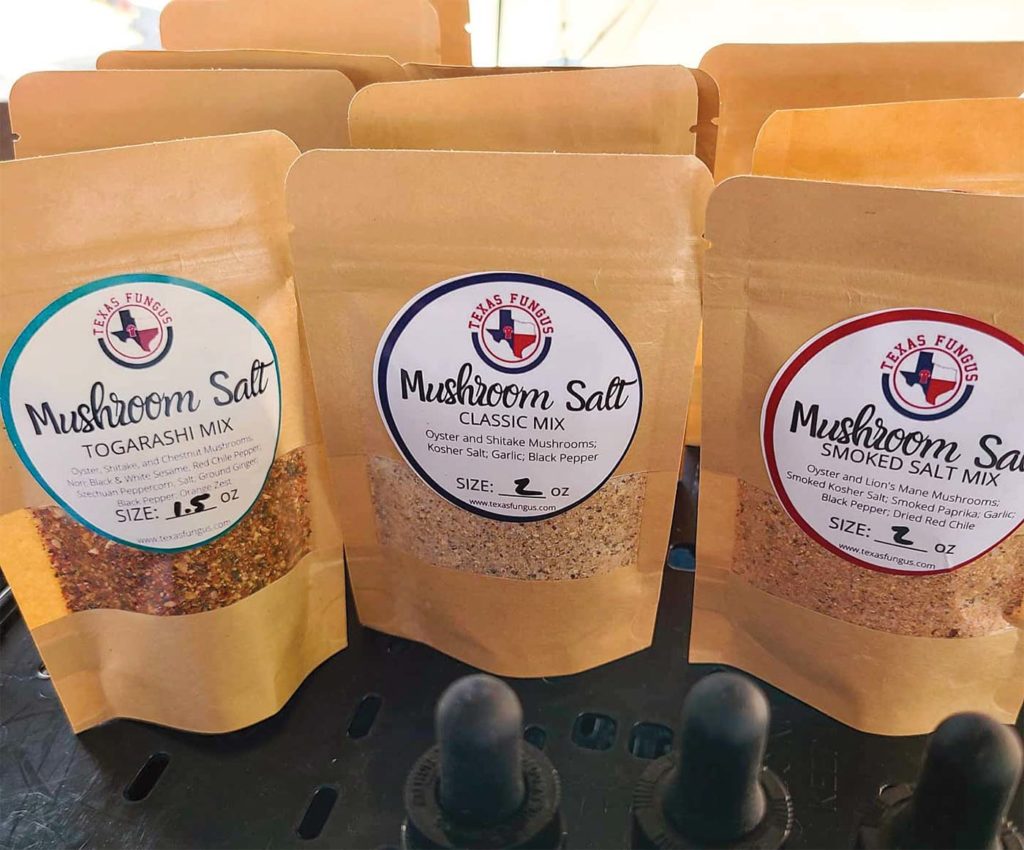
The Fruits of their Labor
On the farm, they also diversified the types of mushrooms that they were growing from five species to more than a dozen at one point. Texas Fungus now has a total of ten species in regular production with plans to expand as they perfect new techniques.
“Currently, we have three different species of Oyster Mushrooms, Lion’s Mane, Comb’s Tooth, Chestnut, Pioppino, Maitake, Shimofuri and Shiitake but every now and then we will play around with different and weird varieties that no one has ever seen before,” says Jent.
That innovation has paid off with a harvest increasing to 400 to 600 pounds of mushrooms each week grown in their 2,000 sq ft urban farm space.
A Truly Urban Farm
Located in an industrial part of Arlington, the Texas Fungus indoor farm is 100% climate-controlled with cultivation rooms that stay at constant temperature/humidity year-round.
Each step of their mushroom cultivation process is precisely organized and supervised for productivity and sanitation. In their workroom the mushroom substrate is mixed, and plastic grow bags are filled and sterilized. The product is then moved to a lab, complete with HEPA filtration to prevent contamination where the mushroom spawn inoculated grains are mixed into the grow bags.
Depending on the species of culinary mushrooms, they take two to ten weeks for the fungal root-like mycelium to fully colonize the substrate. That’s when the magic happens. Based on the climatic requirements of the species they are then moved into one of two fruiting rooms where over a course of one to two weeks mushrooms begin to erupt from the grow bags.
“The upside is that (as long as we have electricity) our growing season is not limited by summer heat or winter cold,” says Cohen.
“We can grow a fair amount of food in relatively a low square footage space with less carbon footprint than traditional methods of growing field crops” adds Jent.
After countless hours and dedication, their perfected operation has another major upside compared to traditional in-ground farming. They can go from start to finish (inoculation to harvest) on many of their mushrooms in roughly three weeks with their longest cultivated species only taking about 10-12 weeks. They plan on trimming 2 weeks off that timeline with future improvements.
The major challenge they face during the summer months is not so different than traditional farmers — the Texas heat.
Jent explains that because mushroom fruiting bodies prefer to be in a cool and humid environment (some species preferring less than 60 F) that for about six months out of the year, even with their insulated and efficiently designed grow rooms, their electric costs seem to grow as fast as their crops.
Jent jokes that during the summer their air conditioning units are running every second of every day that ends in the letter Y.
“Growing mushrooms is like any other type of farming — just when you think you have things figured out, something comes along that changes your whole perspective. So, from that aspect, it is very rewarding to see the “fruits” of our labors quite literally grow in front of our eyes,” says Cohen.
“For me, it’s much more interesting and rewarding to be a part of the food supply chain. A lot of things have to go right in order to do what we do consistently, and I’ve never been one to shy away from a challenge,” says Jent.
As the pandemic slowly wanes, and their essential restaurant partners continue to recover from a tough year, more North Texans will be able to enjoy the full spectrum of mushroom offerings, prepared by chefs at Harvest, The Rosewood Mansion on Turtle Creek, Café Momentum, Salum, St. Anne’s, Oddfellows, Bonnell’s or a handful of other dining establishments across the region.
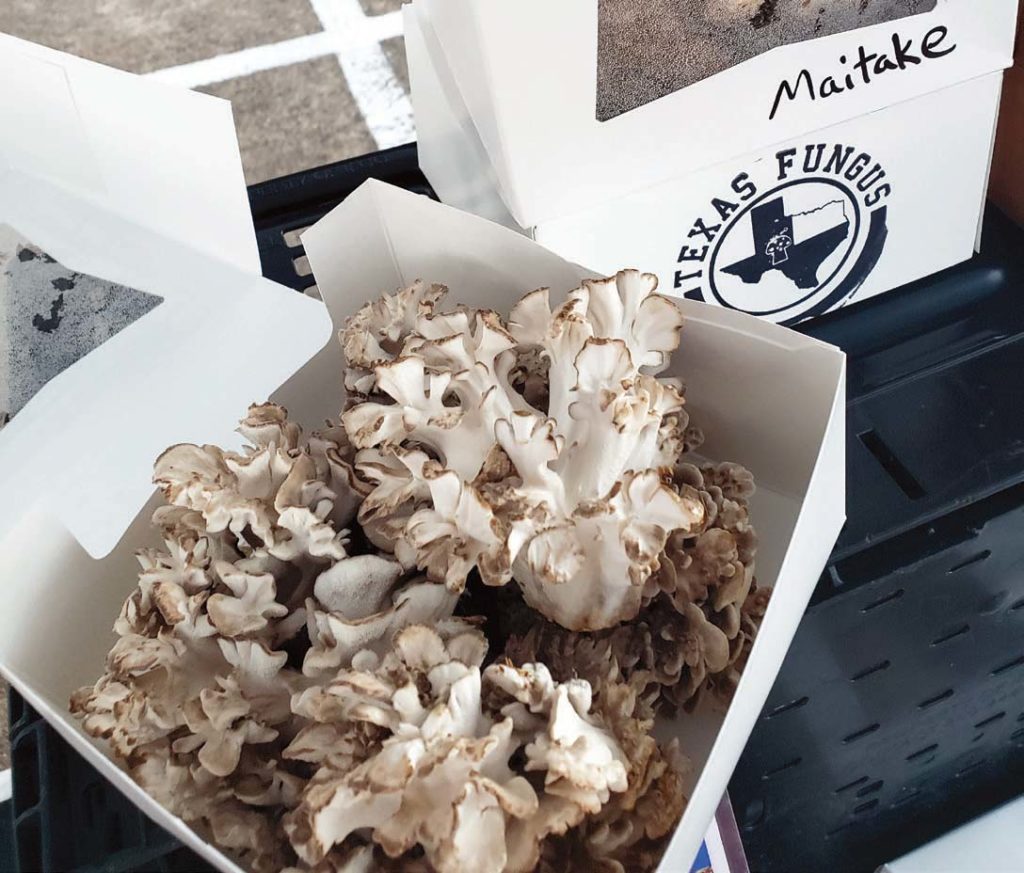
Grow Mushrooms At Home
Visit these fun guys for mushroom jokes and fun-gi kits at Dallas Farmers Market, Good Local Markets, Cowtown Farmers Market, Saint Michael’s Farmers Market, or you can order directly from TexasFungus.com. They’ve made their GIY (Grow It Yourself) bags simple and easy to care for ready to go with your choice of Oyster mushroom, King Trumpet and Lion’s Mane spawn — with almost the same grow bag setup they use at the farm. Each 4-pound kit yields approximately 1 to 1.5 pounds of mushrooms over the first two flushes.
- Visit TexasFungus.com to learn more.
Steps to grow mushrooms at home:
Step 1: Place grow bags on a counter or shelf with indirect sunlight.
Step 2: Cut several slits in plastic to expose mycelium and allow mushrooms and area to fruit.
Step 3: Mist bags 2-3 times a day until fruiting begins (generally 1-2 weeks).
Step 4: Harvest mushrooms with a sharp knife or kitchen shears.
Step 5: Continue to spray and monitor the grow bag for a 2nd flush and harvest again!
Step 6: Then discard the used bag contents into your garden mulch and monitor during wet weather to see if you can get them to fruit again.
Daniel Cunningham, Horticulturist with Texas A&M AgriLife's Water University program. His primary focus is a holistic approach to landscaping and food production systems. Cunningham specializes in Texas native plants and trees, vegetable gardening, edible landscaping, rainwater harvesting and is passionate about utilizing landscapes as habitat for benecial wildlife. For more gardening advice om Daniel, tune in to NBC DFW (Channel 5) on Sunday mornings or ask @TxPlantGuy on Facebook, Twitter or Instagram.
- Daniel Cunninghamhttps://www.edibledfw.com/author/dcunningham/
- Daniel Cunninghamhttps://www.edibledfw.com/author/dcunningham/
- Daniel Cunninghamhttps://www.edibledfw.com/author/dcunningham/
- Daniel Cunninghamhttps://www.edibledfw.com/author/dcunningham/




